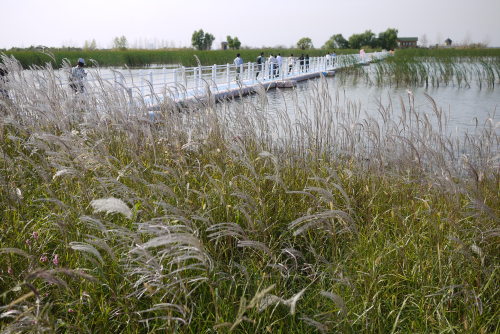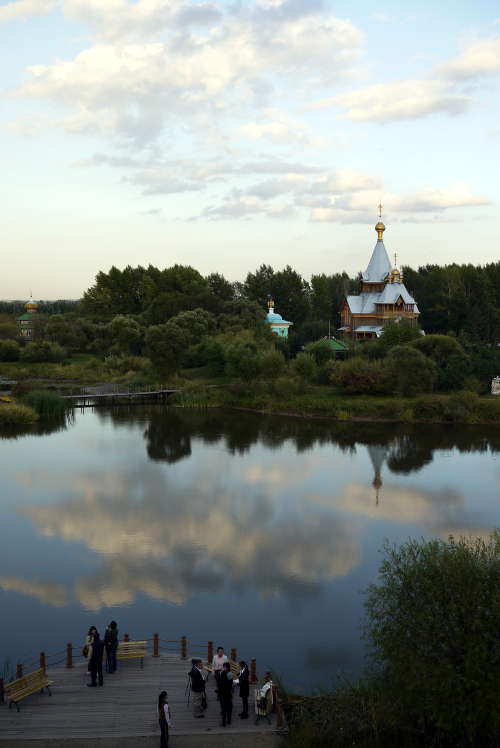HARBIN, China ― Many Koreans are familiar with the spectacular Harbin Ice and Snow Festival in northeastern Heilongjiang Province, China.
“Air tickets and hotels for the ice festival are usually sold out during the peak season in the winter,” said an official from a Seoul-based tour firm specializing in tour programs in China. “But the tour program sales are slow in the summer,” she added.
What’s yet to be known widely among Koreans is that Harbin’s tourism resources are spread out evenly throughout the year, with its wonderful natural beauty drawing a growing number of international tourists and fast-paced development projects improving tourism infrastructure.
Harbin, also known among many Koreans as a city where independence fighter An Jung-geun assassinated Ito Hirobumi who led the colonization of Korea, is called “city of ice and capital of summer,” “city of music,” and “oriental Moscow” for its diverse cultures and natural scenery.
“Harbin is a place where East meets West, which has a unique city planning and designing style,” Lin Duo, mayor of Harbin, told reporters from Asian media affiliated with the Asia News Network in a program organized by the Harbin City Party Committee and China Daily, a state-run English language newspaper.
Along with its expanding tourism industry, Lin said the city is pushing forward with four large-scale development projects such as a new high-tech town on the northern bank of the Songhua River and the upgrade of the environment and urban facilities in the downtown area.
Just a two-hour flight from Seoul, Harbin offers engaging hotspots that are not available in other regions in Asia. First and foremost are the city’s wetland areas. Covering about 125,000 hectares, the wetlands are Harbin’s greatest ecological resource.
 |
Binjiang Wetland, Harbin’s largest and newest wetland, offers a unique ecological vista. (Yang Sung-jin/The Korea Herald) |
Sun Island Wetland
The Sun Island Scenic Spot, located on the north bank of the Songhua River and separated from Harbin’s downtown area by a pool of water, is one of China’s best-known summer resorts.
To the northwest there is an interesting swamp with a sparse group of trees and marshy grass. The wetland itself is Harbin’s largest marshy grassland area, and one of the best of the wetlands.
People who arrive either by water or by road can feel the connection between the river, the island, and the city. This wetland is also at the root of Ice City, a place where the river, island and city are co-dependent.
A walk along the stone-paved road to Sun Island Wetland opens up an eye-opening view where clear water, a blue sky, white sand, and marshy grasslands are preserved in a special protection zone.
Jinhewan Wetland Park
This park is a river-restoration demonstration site. Before 2008, half of it was farmland and completely lacking in wild plants along the 5,000-meter coastline, which was covered in white sand.
Now, the park has water on three sides and is rich in biodiversity, with a free-flowing water system. Great changes have taken place here with the planting of 60,000 trees, 300,000 square meters of ground cover, more than 2 million aquatic plants, 1000,000 willow trees, and various plants restored.
The park has not only flowing water, winding roads and green islands but also numerous rare plants, such as wild Chinese chives, water lilies, mulberry trees and alder.
Binjiang Wetland
This 104-square-kilometer area is Harbin’s largest and newest wetland park. Construction on the site began early this year, but the park has already completed many of its projects to emerge as a tourist spot.
The wetland, transformed from farmland, comprises of four zones and one park including Blue water and Clear Sky, Jade Belt Bay, the Gold River Bank. Here visitors can soothe their eyes by gazing at the beautiful landscape.
The park’s floating bridge is a prominent attraction that can also withstand extreme weather and serves as a unique scenic point. In addition, the floral fairy statue and fishermen’s shelters show how much the local people have contributed to turning the farmlands into a beautiful tourist region in a short period of time.
 |
Volga Manor is Harbin’s famous Russian-style lodging facility. (Yang Sung-jin/The Korea Herald) |
Central Street
The 1.45-kilometer-long Central Pedestrian Street is Harbin’s equivalent of Paris’ Champs Elysees. The street leading to the obelisk in commemoration of flood control of the Songhua River incorporates styles from Baroque to Art Nouveau. Lovingly restored to their former grandeur, the buildings along this corridor of architectural diversity offer vibrant commerce and the best people-watching opportunities in town.
The street has numerous commercial buildings, leisurely communities and a dazzling cultural life. At night, the street is ablaze with lights, attracting crowds of people, and making full use of its tourism, shopping, entertainment facilities.
Not far away from the Central Street, visitors can check out the famous Saint Sophia Cathedral. This Russian Orthodox church was built in 1907 and rebuilt in 1923. It is a lonely reminder of the time when more than a dozen Russian churches dotted the city landscape. Now stripped of its religious function but largely refurbished, it houses a museum that displays photos and miniatures of old Harbin in a mythical haze. Since its restoration in 1997, the green-domed red-brick, Byzantine structure has become a city landmark.
Volga Manor
About half an hour outside downtown Harbin is a place called Volgar Manor, a lodging where visitors might feel they are actually in Russia. Its Sun Island Jiangshang Restaurant and 20 other buildings bear a distinctive Russian style. The gates of the manor make it look like a medieval castle, and imitate some of the older buildings of Irkutsk, Russia. These Russian-style buildings give the landscape a splendid, exotic touch.
Volga Manor, nestled alongside the Ashihe River in Harbin’s Xiangfang District, has also Saint Nicholas Church. Built in the late 19th century, it was the biggest landmark in Harbin until Red Guards tore it down in 1966. Now the wooden structure stands in this 60-hectare theme park by a quiet river.
By Yang Sung-jin, Korea Herald correspondent
(
insight@heraldcorp.com)









